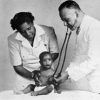calsfoundation@cals.org
Lawrence Memorial Hospital
Lawrence Memorial Hospital opened in Walnut Ridge (Lawrence County) on June 1, 1960, becoming the largest employer in Lawrence County and the major economic contributor to the city of Walnut Ridge.
After World War II ended, President Harry S. Truman focused much of his attention on healthcare reform. In 1946, he secured passage of the Hill-Burton Act, which provided federal grants and loans for the construction of local hospitals and other health facilities. Hoping to tap into these new federal funds, leaders in Lawrence County made an effort to establish a local hospital in 1947. But when the county’s citizens went to the polls to decide whether the county would raise the tax revenue to cover the local share of the costs, only 975 people voted for the hospital measure, while 1,174 voted against it. Consequently, the county would go another decade without a local hospital.
Dr. Ralph Joseph of Walnut Ridge went to the county’s political leaders in 1957 and asked if the construction of a local hospital facility could be considered again on the November ballot. His efforts were successful; in what the Times Dispatch called, “A Mandate from the People,” the county’s citizens overwhelmingly supported the hospital measure, voting 2,278 for and only 298 against.
The total construction and initial equipment costs for the hospital amounted to $525,000. The county provided $175,000, and the rest of the cost, $350,000, was covered by the federal government through the Hill-Burton Act funds. The county purchased land for the hospital from R. E., Una, and Jeanette Thornburgh in June 1958. County Judge Brooks Penn appointed five men to serve on a building committee with him to supervise the hospital’s construction: Dr. Ralph Joseph, D. Leonard Lingo, Jerry Bassett, Charles Snapp, and William (Bill) Rainwater.
A board of governors was established to oversee the new health facility. Those serving on the founding board were Roy Pickett, D. Leonard Lingo, Chairman G. H. Ring, Jeff Matthews, Glenn Allen, John Moore, Tom Sloan, and Kenneth Sanders. Sanders was also appointed as the hospital’s first administrator, and eight doctors were hired, as well as nurses and lab technicians. A superintendent of nurses, head of laboratory and x-ray, chief cook, and office manager were also hired.
To celebrate the opening of the hospital, a “Walking Blood Bank” was held, in which about 500 people donated blood. The dedication ceremony, attended by hundreds, honored those soldiers from the county who lost their lives in World War I, World War II, and the Korean War. Lawrence Memorial officially opened its doors on June 1, 1960. It consisted of forty beds; eight rooms were private, and the rest were semi-private. The semi-private rooms cost $9.00 per day, and the private rooms, which had either a shower or tub, cost $13.00 a day.
While the hospital was still under construction, plans were made to add a nursing home. It cost $125,000 to build, and two-thirds of those funds were provided through the federal Hill-Burton Act. Opening in 1962, the convalescent home, named Lawrence Hall, consisted of twenty-eight beds. In addition to the patient rooms, the facility included a dining room, a utility room, lounges, patios, and a nursing station. Hospital administrator Kenneth Sanders had advertisements placed in newspapers in the surrounding areas, and even in Kansas City and St. Louis, Missouri, to hire nurses to work at either the hospital or nursing home. After 1960, County Judge Brooks Penn, in one of his campaign speeches for reelection, stated, “Numerous people who have had the occasion to use it, say that they have received the best of care and remark that we should have had it years ago.”
In 1981, Lawrence Memorial and St. Bernards Hospital in Jonesboro (Craighead County) secured a long-term management deal. Through the agreement with St. Bernards, Lawrence Memorial is able to use the much larger Jonesboro hospital’s purchasing power to buy supplies and medical equipment at reduced costs, which translates into lower costs for medical services and major savings for local taxpayers. Lawrence Memorial is also able to use St. Bernards’ technological and industrial expertise to improve the healthcare services it offers.
In the twenty-first century, in addition to the health services it provides for local citizens, Lawrence Memorial is the largest employer in the county, with around 350 employees. Its physical plant and property are worth over $11 million. Junior Briner of Walnut Ridge, who served as the chief operating officer of the hospital for more than fifty years, stated that the local healthcare institution is “the economic driving force of the community.”
For additional information:
“Building Committee of Five Named by Judge Penn.” Times Dispatch, September 4, 1958.
“Construction of the Hospital Will Start Very Soon.” Times Dispatch, February 12, 1959.
“Convalescent Home Proposed for County; Funds Are Now Available. Times Dispatch, February 7, 1960.
“Hospital Administrator Appointed.” Times Dispatch, December 31, 1959.
“Hospital Bids to Be Received.” Times Dispatch, December 11, 1958.
“Hospital Is 60 Percent Completed.” Times Dispatch, July 30, 1959.
“Hospital to Take Patients on Tuesday.” Times Dispatch, May 26, 1960.
Koons, Hannah. “‘A Mandate from the People’: The History of Lawrence Memorial in Walnut Ridge, Arkansas.” Lawrence County Historical Journal 2021, no. 2, pp. 6–30.
Lawrence Memorial Hospital. https://www.lawrencememorial.info/ (accessed March 31, 2023).
“A Mandate from the People—Build the County Hospital.” Times Dispatch, November 7, 1957.
Hannah Koons
Pocahontas, Arkansas





Comments
No comments on this entry yet.